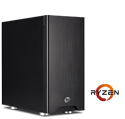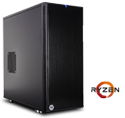04.09.2019 | ISSUE 03
This month as an NVIDIA Elite Partner we give an insight into Data Science Workstations; we follow up on Scan's sponsorship of the NVIDIA Enterprise Innovation day in May and we also explore the latest from HTC and how their implementation of eye tracking boosts the capabilities of the Vive within Commercial VR market.

NVIDIA Data Science Workstation Launch
This month we are happy to announce that Scan now offer POC on our NVIDIA Data Science Workstations. Powered by the latest NVIDIA Turing GPU Architecture, these systems have been created for Data Scientists of organisations to create a Minimum Viable Product (MVP) with their data sets.
NVIDIA-powered Data Science workstations are tested and optimised with data science software built on NVIDIA CUDA-X AI, a collection of over 15 libraries that enable modern computing applications to benefit from NVIDIA’’s GPU accelerated computing platform. It features RAPIDS data processing and machine learning libraries, NVIDIA optimised TensorFlow, PyTorch, Caffe and other leading data science software, providing enterprises with accelerated workflows for faster data preparation, model training and data visualisation.
As well as this, DL and AI frameworks, which are supported for the DGX-1, DGX-2 and DGX Station, are also supported within the NVIDIA Data Science Workstations (DSW). With this support brings flexibility and portability of work from the MVP across the complete DGX Family of systems.

Organisations are investing in Data Science for deep learning and AI to improve their time to market, increase efficiency in their organisation and to unlock the value from their combined data sets. We understand that investing in hardware for deep learning and AI can be tough when in-experienced in the industry, which is why your NVIDIA Data Science Workstations can now be evaluated online via a Proof of Concept. The Scan AI team will be there for you every step of the way to help guide you through your POC and provide support when needed.
Apply for a POC Trial or get in contact with the scan AI team via [email protected] or get it


NVIDIA Enterprise Innovation Day
On the 30th May 2019 Scan were platinum sponsors of the NVIDIA Enterprise Innovation Day, an event targeting CXOs, IT Managers, Developers, Researchers and Data Scientists from multiple industries, the primary one being Artificial Intelligence & Deep Learning.
AI & DL are changing the way we tackle problems in the world, and Innovation Day was the perfect place to showcase what companies where achieving in the industry. From the challenges being conquered in Drug Discovery through the use of AI, to the lessons being learnt from the Space Industry in designing AI applications. Innovation Day covered it all.
The day started with an opening speech from the VP of Channel EMEA an NVIDIA, Alfred Manhart. Discussing the topic of how GPU computing is transforming every industry, Alfred dived deep into the verticals that would/could be affected by AI, followed by a discussion on how GPU powered virtualisation is mobilising the richest applications and desktops. The talk finished up with a shout out to all of NVIDIAs cross platform and ecosystem partners.
After a customer keynote from John Overington, CIO at MD Catapult, the breakout and classroom sessions started. Attendees were given total control of their own days, deciding what sessions to participate in and which paths they took.
Breakout sessions started with separate tracks for Healthcare, AI City, Higher Education and Research. Some highlights are NVIDIAS vision for a more connected healthcare system presented by Jonny Hancox from NVIDIA, Learning through 8 million patients presented by Jorge Cardoso from KCL and Translating Computer Vision Research to Real-World Applications presented by Moi Hoon Yap from MMU.
In the afternoon the breakout sessions continued, this time covering a range of verticals. Some highlights are the session on Delivering AI Ecosystems presented by Scan Computers CEO Elan Raja, a talk on “start on cloud, scale on premise” presented by Andy Ashton from NetApp and a session on the Deskside data science workstation presented by Steve Walker from Arup.
The afternoons Technical Deep Dive session continued on from the morning, this time going through how to get a vGPU Proof of Concept up and running. This was followed by a 1:1 vGPU session and an open session for MMU students to come and learn more about AI & Deep Learning, hosted by Scan Computers Data Science team.
Throughout the day the Scan Computers Data Science team ran a NVIDIA Deep Learning Institute. The DLI instructor led sessions focused on the Fundamentals of Computer Vision. This path took the entire day and gave attendees the chance to get hands on training solving challenging problems with deep learning and accelerated computing. Scan also offer DLI in the workplace, which revolve around instructor-led workshops in your place of work. Now you can solve challenging problems with deep learning without leaving the office. To find out more and register your interest in any future Deep Learning Institutes offered by Scan, click here: https://www.scan.co.uk/business/deep-learning-institute, call us on 01204 474747 or email us at [email protected].

Before finishing the day off with some networking we announced the winner of the prize draw. A NVIDIA Jetson Nano Developer Kit was awarded as 1st prize, a two week extended Proof of Concept was awarded to the first runner up (courtesy of Scan Computers) and the next three runner ups received a code for a free NVIDIA DLI online course.
Thank you to all of our partners and to everyone who attended. To keep in the loop with any events that Scan are hosting/attending make sure to follow us on our socials:


HTC VIVE Pro Eye
In this month’s Tech spotlight we are featuring the HTC VIVE Pro Eye. Built for the most demanding professional users, the new VIVE Pro adds precision eye tracking to its renowned feature set of world-class graphics, high-end audio, and expansive modular tracking. Designed with power, depth, and scalability in mind, the VIVE Pro Eye works in seated, standing, and expansive multi-user environments to accelerate timelines, enhance training and design, and simulate impossible scenarios.
The addition of precision eye tracking to the already established VIVE Pro, has furthered the gap between the Vive pro and any other VR headset in the market. The Precision eye tracking improves the user experience in various ways with the key benefits being the following:
Expand User Analytics - Understand intentions & improve feedback.
- Measure eye movement, attention, and focus at any given time with astounding accuracy
- See what users see and for how long with heatmapping and gaze tracking
- Understand how users naturally interact with your product.
- Uncover actionable insights about user intention and decision-making processes.
Simplified Input & Navigation - Make handheld controllers optional.
- Implement gaze-oriented menu navigation
- Point, select, and zoom faster and easier than ever before.
- Enable more natural movements and gesture controls in virtual reality.
Foveated Rendering - Intelligent allocation of GPU workload.
- Optimize graphic fidelity in users' line of sight
- Reduce rendering workloads on CPUs and GPUs.
- Improve visualization quality and performance
- The preferred system for NVIDIA Variable Rate Shading (VRS) technology.

VR-Ready Desktops by 3XS
While most people associate VR with a headset, it is really a complete communication platform and involves more than just one component. Although the headset is key to the experience, it is the system components that are critical for real-time rendering – the CPU and GPU. All 3XS VR-ready workstations include the latest optimised components to ensure the most immersive VR experience.



